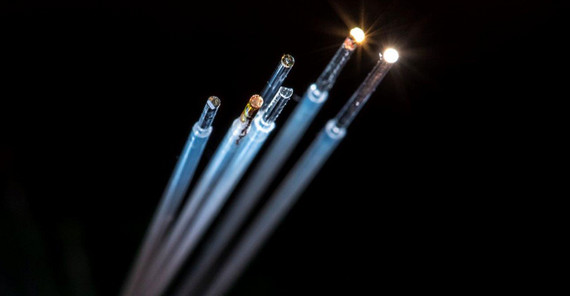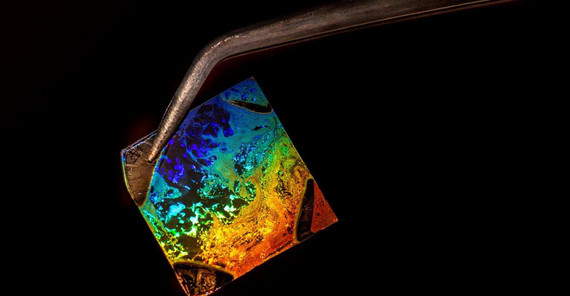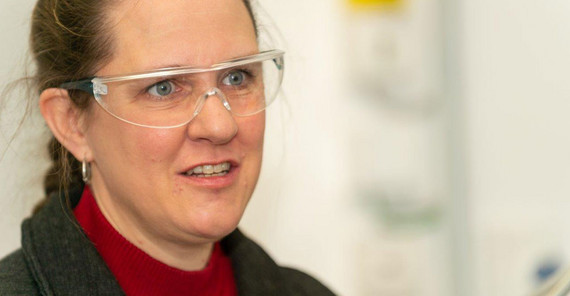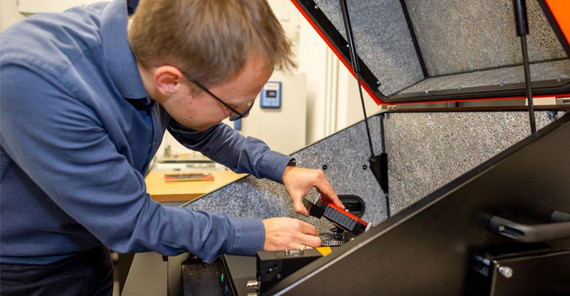In a hospital, an oncologist examines a patient with a plain instrument that looks much like an electric cable connected to a small box. At the tip of the instrument, there seems to be a light source. The physician inserts the instrument through a small incision and “illuminates” some suspicious-looking tissue to check for tumor cells. No sample needs to be taken, no laboratory results to be waited for. The device, a multi-parameter biosensor system, or MBS, is able to identify tumor cells reliably in just a few seconds. A little later, the doctor uses the same MBS to administer a drug that fights the cancer with perfect precision, and afterwards the MBS records changes in the tissue as tumor cells die.
Optical fibers for precise diagnostics
Sounds like science fiction? It is – but maybe it won’t be long until the researchers of the "OptiZeD" consortium have attained their goal and developed the device, at once a tool for medical analysis, diagnosis, and therapy. "It would be an important step towards meeting the challenges of personalized medicine," says chemist Prof. Dr. Ilko Bald. Together with Dr. Claudia Pacholski he leads the Potsdam research groups that take part in the project. Both have their research focus on nanomaterials which play a key role in the MBS as its core consists of optical fibers coated with nanostructures serving as sensors. "For example, they could help identify inflammatory or cancer biomarkers. During an examination, the device sends an optical signal through the fibers. If the searched-for biomarkers dock on the nanomaterials, the signal will change and the physician can tell whether it is an inflammation or cancer," Bald explains.
How optical fibers can be used for measuring has been studied for a number of years at the research and innovation center "innoFSPEC" in Potsdam where Bald, Pacholski, and their working groups are also based. "There is a lot of prior knowledge about optical fibers here, which helps enormously,” Pacholski says. Three working groups from TU Dresden are also participating in the project. Their research objective is to fit optical fibers with active substances to be released at the end of a medical examination, if required. This way, diagnosis and treatment could be combined, and therapies administered to the exact site of the disease. Besides, treated tissue could be directly observed to see whether a drug is working. A very comfortable solution, and by no means extraordinarily costly, as Pacholski points out: "It's quite conceivable that this sort of tool will be available at every specialist's practice one day. And the – coated – optical fibers would even be the cheapest part of it. They could be disposable and thus absolutely hygienic to use."
To achieve this, we still have a long way to go, Bald knows. "Today, we are laying the groundwork by developing the model and the necessary technologies. Compared to that, attaching different sensors later on will be a walk in the park." So for now, what nanomaterials are suitable for what type of sensor? How can they be firmly fixed to optical fibers? And how can they be modified to become sensors for detecting biomarkers, cells, or sounding an alarm when certain values are exceeded? "This is a major technological challenge," Pacholski states. “We are testing various materials to cover different sensory functions."
Foldable DNA structures and versatile gold particles
Bald has been researching DNA nanostructures for years. Using DNA origami, he folds DNA to create two- or three-dimensional structures. "The great thing is that these structures can be controlled very precisely," he says. As part of the "OptiZeD" project, Bald plans to use them to develop two sensor systems: One to measure the ambient pH value. "This is quite instructive for some disease patterns," Bald remarks. For this purpose, the researchers use fluorescent dyes that change their fluorescence at certain pH values. "As the signal of the optical fibers is modified, too, we can use it to calculate pH levels," Bald says. In this case, the fluorescent dye practically binds to the DNA structure. In the second application, DNA segments will be used as sensors. "Our Dresden partners have developed a sequence that can serve as a receptor for certain molecules – for example those indicating inflammatory processes." Now, Bald and his team are planning to incorporate these sequences into nanostructures to be used for the coating of optical fibers.
In contrast to that, Pacholski works with metallic nanostructures such as hole pattern structures or gold particles. "They have great properties," she says. "It’s easy to fix molecules to them, and they can amplify signals." In addition, gold-coated optical fibers can be used to heat pathological tissue and kill cancer cells, for example. "It could be possible to develop a thermal therapy for cancer on this basis. We are experimenting in several directions."
Exchange at a distance
Due to the Corona pandemic, collaboration with the Dresden partners has been limited to video conferences and communication by e-mail or mail over the last few months. "We planned to see each other much more often, and work together in the lab," Bald states. Unfortunately, this has not been possible. But as researchers, they have been used to digital cooperation for a while. "We even held virtual meetings to align lab setups for experiments," Pacholski adds. And the required data and preparations can be exchanged by e-mail or mail.
With or without Corona – Bald, Pacholski, and their partners need a lot of staying power. Bald believes that it may well take years until the MBS will finally be available: "'OptiZeD' has a duration of three years. Even so, we are already planning for three phases: The first is our current project, intended to provide the proof of principle. In the second, we intend to transfer our results to real cell systems and test them in their entirety at the cellular level." And in a third phase, we will look at the technical realization of the device and test it in medically relevant settings. The long road ahead does not dampen the two researchers’ enthusiasm. "The work is fascinating," Pacholski says. "I’m thrilled by the prospect of finding practical applications for these seemingly very abstract nanostructures."
The Researchers
Dr. Claudia Pacholski studied food chemistry at the University of Hamburg. She has been a Heisenberg Fellow at the Institute of Chemistry at the University of Potsdam and head of the "Functional Nanomaterials" group since 2016.
Mail: claudia.pacholskiuuni-potsdampde
Prof. Dr. Ilko Bald studied chemistry at FU Berlin. In 2013, he became Junior Professor for Optical Spectroscopy and Chemical Imaging at the University of Potsdam, where he has been Professor for Hybrid Nanostructures since 2019.
Mail: ilko.balduuni-potsdampde
The Project
For their project "Optical Cell Diagnosis and Manipulation" (OptiZeD), the centers for innovation competence Center for Molecular Bioengineering (B CUBE) at TU Dresden and Innovative Optical Fiber Spectroscopy and Sensing (innoFSPEC) at the University of Potsdam receive funding to the tune of approximately three million euros from the German Federal Ministry of Education and Research (BMBF). A novel, miniaturized multi-parameter biosensor system (MBS) will allow innovative methods to be used in personalized medicine.
innoFSPEC is a research and innovation center pursuing multidisciplinary research in the field of optical fiber spectroscopy and sensing. The center was created as a joint venture of the Leibniz Institute for Astrophysics Potsdam (AIP) and the Physical Chemistry group of the University of Potsdam (UP).
https://innofspec.de
This text was published in the university magazine Portal Wissen - One 2021 „Change“.




